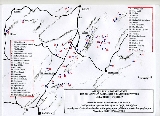
Rock art of the Djelfa region
Encyclopedia
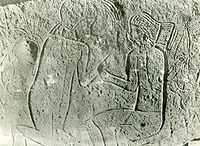
Djelfa
Djelfa is the capital city of Djelfa province, Algeria. It has a population of 154,265 . The city lies at the junction of the N1 and the N46....
region (Algeria
Algeria
Algeria , officially the People's Democratic Republic of Algeria , also formally referred to as the Democratic and Popular Republic of Algeria, is a country in the Maghreb region of Northwest Africa with Algiers as its capital.In terms of land area, it is the largest country in Africa and the Arab...
) consists of prehistoric engravings of Neolithic
Neolithic
The Neolithic Age, Era, or Period, or New Stone Age, was a period in the development of human technology, beginning about 9500 BC in some parts of the Middle East, and later in other parts of the world. It is traditionally considered as the last part of the Stone Age...
age which have been recognized since 1914. Following the Sahara
Sahara
The Sahara is the world's second largest desert, after Antarctica. At over , it covers most of Northern Africa, making it almost as large as Europe or the United States. The Sahara stretches from the Red Sea, including parts of the Mediterranean coasts, to the outskirts of the Atlantic Ocean...
n Atlas Mountains
Atlas Mountains
The Atlas Mountains is a mountain range across a northern stretch of Africa extending about through Morocco, Algeria, and Tunisia. The highest peak is Toubkal, with an elevation of in southwestern Morocco. The Atlas ranges separate the Mediterranean and Atlantic coastlines from the Sahara Desert...
they follow on from those, to the west, of south Oran
Rock art of south Oran (Algeria)
The rock art of south Oran, are prehistoric engravings of Neolithic age in the south of Oran Province, Algeria, in the Saharan Atlas Mountains, in the regions of Figuig, Ain Sefra, El-Bayadh, Aflou and Tiaret. Comparable engravings have been described, even further east, around Djelfa and in the...
(the regions of Figuig
Rock art of Figuig
The rock art of the Figuig region of Morocco consists of prehistoric engravings of the Neolithic age. They belong to the wide south Algerian group "Sud-oranais" . They are east of the rock art of the Atlas mountains...
, Ain Sefra, El-Bayadh, Aflou and Tiaret), to which they are related. Comparable engravings have also been described further to the east, in the Constantine (Algeria)
Constantine, Algeria
Constantine is the capital of Constantine Province in north-eastern Algeria. It was the capital of the same-named French département until 1962. Slightly inland, it is about 80 kilometres from the Mediterranean coast, on the banks of Rhumel river...
region.
Localities and descriptions
Some of the engravings of the Djelfa region seem to have been known since the 1850s (El Idrissia). Among the best-known, those of ZaccarZaccar
Zaccar is a town and commune in Djelfa Province, Algeria. According to the 1998 census it has a population of 3,142.-References:...
were discovered in 1907, and Flamand described in 1914 the station of Daïet es Stel. In the mid-1960s the active Djelfa Council of Initiatives undertook to record engravings and paintings, and Father F. de Villaret, who accompanied the visitors, thus made known works from some twenty new stations, notably those of Oued el Hesbaïa and Aïn Naga
Aïn Naga
Aïn Naga is a town and commune in Biskra Province, Algeria. According to the 1998 census it has a population of 10,054.-References:...
. In total more than 1,162 engravings have been discovered in the region.
Henri Lhote
Henri Lhote
Henri Lhote was a French author, explorer, ethnographer, and "expert on prehistoric cave art" who described and is credited for the discovery of "important cave paintings" in an "assembly of 800 or more magnificent works of primitive art...in a virtually inaccessible region on the edge of the...
referred to these engravings in his major work, Les Gravures rupestres du Sud-oranais, which he published in 1970 in the series of the Mémoires du Centre de recherches anthropologiques préhistoriques et ethnographiques (CRAPE). For him they could not "be separated archaeologically from those of south Oran, because they show with some variations the same style, the same technical formulae, the same patinations and the same fauna"(p. 194). It may therefore be possible to analyse them making use of the hypotheses and the classification which he developed. The engravings of the Djelfa region appeared to him like "foreign works, which are a copying (always of inferior quality) from those of south Oran
Oran
Oran is a major city on the northwestern Mediterranean coast of Algeria, and the second largest city of the country.It is the capital of the Oran Province . The city has a population of 759,645 , while the metropolitan area has a population of approximately 1,500,000, making it the second largest...
", (p. 193), a region which for the author was "the principal centre of the rock art of the pre-Saharan regions." Some belong to the earliest stage of the large-scale Hartebeest school, like "The Apollo of Ouled Naïl", others are more recent or indeed (stylistically) more decadent.
Regretting "the misreading of the importance of the south Algerian rock art" in the work of Lhote, P. Huard and L. Allard published in 1976 in Lybica (CRAPE, Algiers) an important study on Les figurations rupestres de la région de Djelfa, Sud Algérois. The authors therein recorded forty-three numbered sites or stations which are with some exceptions located near the interior or at the edges of a triangle formed on the north by the town of Djelfa, on the south-west by the village of Sidi Makhlouf
Sidi Makhlouf
Sidi Makhlouf is a town and commune in Laghouat Province, Algeria. According to the 1998 census it has a population of 8,061.-References:...
and on the south-east by the town of Messaad.
- http://www.wikimapia.org/#lat=34.350239&lon=3.261566&z=10&l=2&m=a&v=2 The region of Djelfa on Wikimapia.
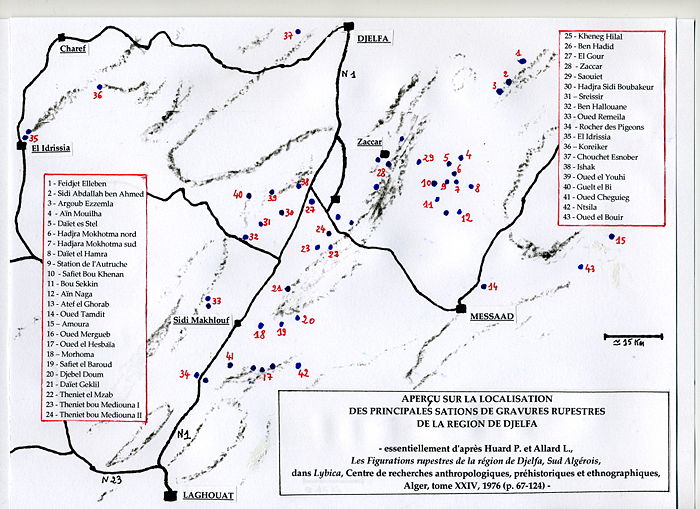
Around the road from Djelfa to Messaad (by Moudjbara) twelve stations follow roughly from north to south: no 29 (Saouiet), 4 (Aïn Mouilha), 5 (Daïet es Stel), 6 (Hadjra Mokhotma north), 7 (Hadjara Mokhotma south), 10 (Safiet Bou Khenan)), 9 (Station de l'Autruche "Ostrich"), 8 (Daïet el Hamra), 11 (Bou Sekkin) , 12 (Aïn Naga), 13(Atef el Ghorab), 14 (Oued Tamdit). To the east of Messad two final stations are named: no 43 (Oued el Bouir) and 15 (Amoura).
The engravings are located near dwelling sites, shown by the presence of worked flints and debitage, "stratified in various levels or at the foot of cliffs of reddish sandstone, the patina
Patina
Patina is a tarnish that forms on the surface of bronze and similar metals ; a sheen on wooden furniture produced by age, wear, and polishing; or any such acquired change of a surface through age and exposure...
of which can become nearly black, which run along the djebels or stand at the edges of the oueds." They are "by-and-large arranged in little separate groups", the monumental friezes or very richly decorated murals like those of Oued el Hesbaïa or Aïn Naga
Aïn Naga
Aïn Naga is a town and commune in Biskra Province, Algeria. According to the 1998 census it has a population of 10,054.-References:...
being "exceptions".
Recognizing that the engravings of the Djelfa region are "similar to those of south Oran by subject and technique", P. Huard and L. Allard judge however that they have a rich cultural content of their own which, notably, show the ancient buffalo as bearers of attributes of the heads, and the fact that almost all the ovines (sheep) are endowed with classic spheroids or horns enclosed in a ring, which are a later stylization of the motif"(p. 67). According to these authors "The introduction in the most ancient stage of the south-Oranian of rams with spheroid
Spheroid
A spheroid, or ellipsoid of revolution is a quadric surface obtained by rotating an ellipse about one of its principal axes; in other words, an ellipsoid with two equal semi-diameters....
s can hardly tally with the south-Algerian material, where the most accomplished depictions are often associated with men in developed costume, whereas others, associated with cattle, are clearly of a pastoral epoch" (p. 71).
What is more "The 'bovidian' stage, which would come only in the fourth place in the sequence of the south-Oranian, where it shows a 'decadant' character, is much more developed in the south Algeria
Algeria
Algeria , officially the People's Democratic Republic of Algeria , also formally referred to as the Democratic and Popular Republic of Algeria, is a country in the Maghreb region of Northwest Africa with Algiers as its capital.In terms of land area, it is the largest country in Africa and the Arab...
n." Deducing that these evidences "show that in the two sectors, its origin must certainly be more ancient", Huard and Allard prefer to speak "of a pastoral stage of long duration, with cows and sheep"(p. 71).
The "Hunters" Stage
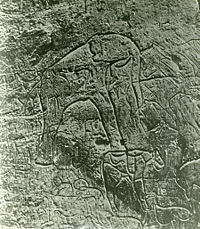
African Buffalo
The African buffalo, affalo, nyati, Mbogo or Cape buffalo is a large African bovine. It is not closely related to the slightly larger wild Asian water buffalo, but its ancestry remains unclear...
(or Hartebeest), elephants, rhinoceros, lions, ostriches and human figures.
Of the seventeen buffalo recorded in the region, twelve belong to the large, naturalistic art and are similar to those of the south-Oranian. They are found at Oued el Hesbaïa (frieze of three buffalo, including one of more than two meters), Aïn Naga (two buffalo in procession), at Station de l'Autruche (buffalo of 1.50 meters surmounted by a hollowed disc), Djebel Doum (buffalo of 2.35 meters of which the left horn supports a "lengthened semi-circular attribute"), Safiet el Baroud, Hadjra Mokhotma north (buffalo of 2.63 meters, where a human figure seems to touch the horns), Kheneg Hilal (buffalo of 1.20 m.) and Ben Hallouane.
Large, medium or small, the twenty-two elephants seem to belong to various ages. The largest (1 to 2 m), naturalistic in style, are found at Aïn Naga, Theniet bou Mediouna I, Oued Remeilia, Aïn Mouilha, Oued el Hesbaïa (where the "elephant
Elephant
Elephants are large land mammals in two extant genera of the family Elephantidae: Elephas and Loxodonta, with the third genus Mammuthus extinct...
panel", an accumulation of depictions superimposed through the centuries, shows six), Safiet Bou Khenan, Zaccar
Zaccar
Zaccar is a town and commune in Djelfa Province, Algeria. According to the 1998 census it has a population of 3,142.-References:...
, Feidjet Elleben and Bou Sekkin.
Seven rhinoceros, of lesser quality and often decadent in style, are recorded at five stations, at Oued Remeila (the oldest), Feidjet Elleben, Bou Sekkin, Aïn Naga, and Oued el Hesbaïa.
Nine representations of Hartebeest antelopes (Bubalis alcelaphus boselaphus) are in naturalistic style. The most famous is that of Zaccar, devoured by a lion (1.50 m in length). A similar scene is found at Daïet el Hamra. At Hadjra Mokhotma north, the animal is confined within a circular trap. Other antelope have been engraved at Safiet el Baroud, Theniet el Mzab and Feidjet Elleben. Otherwise there are numerous antelope-type creatures, often much stylized and in small-scale, like those of Sidi Abdallah ben Ahmed and Safiet bou Khenan, related to the style called the Tazina School, found in south-Oran
Oran
Oran is a major city on the northwestern Mediterranean coast of Algeria, and the second largest city of the country.It is the capital of the Oran Province . The city has a population of 759,645 , while the metropolitan area has a population of approximately 1,500,000, making it the second largest...
.
Eighteen in number, the lions represented can be classed into three groups: "naturalistic lions in profile, three times shown in hunting scenes" (Oued el Hesbaïa, Zaccar, Daïet el Hamra, Hadjara Mokhotma north, Oued Remeilia), "fairly large lions with the stylized head facing and the body in profile", "weaker in style and carving method", "late by comparison with the south-Oran prototypes" (Djebel Doum, Kheneg Hilal, Hadjra Mokhotma south), and thirdly the "smaller felines, lightly drawn and generally late", "of mediocre style and carving method"(pp. 81–85).
The ostriches, fairly numerous, are (with the exception of the representations at Safiet bou Khenan and at Oued el Hesbaïa) "generally of a poor quality." boars, in a group of three, are on the other hand rare, limited to the stations of El Idrissia (a lost group) and Sreissir.
The human depictions are forty in number notably at Oued el Hesbaïa, El Gour, Theniet bou Mediouna II, Aïn Naga, Daïet es Stel, Oued Remeilia, Safiet bou Khenan, Hadjra Mokhotma south and Ben Hadid. Authors attribute to them the model of the "twenty-five characteristic traits of physical or psychic valour of the hunter culture" which they have identified "in the Nile
Nile
The Nile is a major north-flowing river in North Africa, generally regarded as the longest river in the world. It is long. It runs through the ten countries of Sudan, South Sudan, Burundi, Rwanda, Democratic Republic of the Congo, Tanzania, Kenya, Ethiopia, Uganda and Egypt.The Nile has two major...
area and in various Saharan
Saharan
The term Saharan is used in the English language to denote someone or something from the Sahara desert, including:* Sahrawi , referring to the people of the Western Sahara* Saharan languages, a subgroup of the Nilo-Saharan languages...
regions" (p. 85).
Thus they explain the images of men under animal skins, the wearing of false tails and phallic protections, masks, the presence of ithyphallic depictions and of men touching animals (buffalo, antelopes and elephants at Hadjra Mokhotma north, Theniet bou Mediouna II and Bou Sekkin). Among the weapons they record bows, long and curved weapons, clubs, a hatchet and a shield. Several traps are depicted as well as the hands. Thus, "all the cultural traits of hunters are attested in the Djelfa region, apart from the lasso and the spirale (?bolas), which are by compensation strongly represented at Tassili in the Oued Djerat sector."(p. 93).
Early stages of domestication
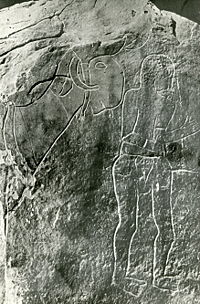
Aïn Naga
Aïn Naga is a town and commune in Biskra Province, Algeria. According to the 1998 census it has a population of 10,054.-References:...
, Daïet es Stel, Oued el Hesbaïa, Saouiet).
It is in this group that some of the most famous masterpieces of the region are found, such as the Ram of Aïn Naga, about twice natural size, found by Father F. de Villaret and published by the Djelfa Syndicate of Initiative. The animal, which wears a spheroid framed by feathers, a cheek pendant and a collar with chevrons, is led by a man dressed in a loin-cloth with buttons, wearing bracelets, whose hair-do falls across the nape
Nape
The nape is the back of the neck. In technical anatomical/medical terminology, the nape is referred to by the word nucha, which also gives the adjective corresponding to "nape" in English, "nuchal"....
of his neck in three swathes.
Of the other ovines (sc. sheep), sometimes wearing collars, show their horns enclosed in a ring or by discs (only four depictions show only a collar, or appear without attributes). At Hadjra Sidi Boubakeur a group composed of a ram, a ewe and a large bull denotes "a well established domestication" (p. 106). Other rams can be seen at Khenneg Hilal, Oued el Hesbaïa, Safiet bou Khenan, Theniet el Mzab, Hadjra Mokhotma and Aïn Naga
Aïn Naga
Aïn Naga is a town and commune in Biskra Province, Algeria. According to the 1998 census it has a population of 10,054.-References:...
.
The rock art of the Djelfa region shows large naturalistic cattle (Zaccar) and sub-naturalistic ones (Bou Sekkin), the others being of the pastoral era. Their horns are similarly closed into a ring and they sometimes wear devices in segments of a circle, or of textile, which are perhaps means of carrying things (Hadjra Sidi Boubakeur, Teniet el Mzab, Hadjra Mohkotma, Ben Hadid, Bou Sekkin, Safiet bou Khenan and Oued Mergueb).
The "pastoral scenes" often associating men and animals are found at Hadjra Sidi Boubakeur, Hadjra Mohkotma sud, Aïn Mouilha (men with "bandes molletières"), ]Morhoma, Daïet es Stel and Zaccar
Zaccar
Zaccar is a town and commune in Djelfa Province, Algeria. According to the 1998 census it has a population of 3,142.-References:...
. Other humanly-signifying depictions, ithyphallic images and women displaying, are found at Safiet bou Khenan, Theniet bou Mediouna II and Daïet el Hamra.

Shield
A shield is a type of personal armor, meant to intercept attacks, either by stopping projectiles such as arrows or redirecting a hit from a sword, mace or battle axe to the side of the shield-bearer....
or quiver
Quiver
A quiver is a container for arrows. Quivers have been traditionally made of leather, bark, wood, furs and other natural materials; modern quivers are often made of metal and plastic....
surmounted by arrows
Arrows
Arrows Grand Prix International was a British Formula One team active from to . For a period of time, it was also known as Footwork.-Origins :...
, (as in south Oran at Khreloua), a hairdo or a headpiece with a tuft of hair falling forwards and with three swathes falling over the neck (a detail which one sees again at Aïn Naga and in south Oran) while the woman shows a carefully maintained hair arrangement, held behind with a clip.
One also finds among the engravings of the Djelfa region hounds and horses of various dates.
In addition three sites with rock paintings are located at Djebel Doum, at Zaccar south (several archers, a possibly human figure and tortoises) and at Hadjra Mokhotma sud.
In 1968 elements of a lithic industry belonging to the Capsian have been found in situ by D. Grébénart at Aïn Naga and dated to 5500 B.C., plus or minus 220.
The probable ancient regional ecology
North Africa enjoyed a fertile climate during the subpluvial era; what is now the Sahara supported a savannaSavanna
A savanna, or savannah, is a grassland ecosystem characterized by the trees being sufficiently small or widely spaced so that the canopy does not close. The open canopy allows sufficient light to reach the ground to support an unbroken herbaceous layer consisting primarily of C4 grasses.Some...
type of ecosystem, with elephant
Elephant
Elephants are large land mammals in two extant genera of the family Elephantidae: Elephas and Loxodonta, with the third genus Mammuthus extinct...
, giraffe
Giraffe
The giraffe is an African even-toed ungulate mammal, the tallest of all extant land-living animal species, and the largest ruminant...
, and other grassland and woodland animals now typical of the Sahel
Sahel
The Sahel is the ecoclimatic and biogeographic zone of transition between the Sahara desert in the North and the Sudanian Savannas in the south.It stretches across the North African continent between the Atlantic Ocean and the Red Sea....
region south of the desert. Historian and Africanist Roland Oliver
Roland Oliver
Roland Oliver is Emeritus Professor of African history at the University of London. Throughout a long career he was an eminent researcher, writer, teacher, administrator and organiser, who had a profound effect on the development of African Studies in the United Kingdom and who has made an...
has described the scene as follows:
[In] the highlands of the central SaharaSaharaThe Sahara is the world's second largest desert, after Antarctica. At over , it covers most of Northern Africa, making it almost as large as Europe or the United States. The Sahara stretches from the Red Sea, including parts of the Mediterranean coasts, to the outskirts of the Atlantic Ocean...
beyond the Libyan desertLibyan DesertThe Libyan Desert covers an area of approximately 1,100,000 km2, it extends approximately 1100 km from east to west, and 1,000 km from north to south, in about the shape of a rectangle...
,... in the great massifMassifIn geology, a massif is a section of a planet's crust that is demarcated by faults or flexures. In the movement of the crust, a massif tends to retain its internal structure while being displaced as a whole...
s of the Tibesti and the Hoggar, the mountaintops, today bare rock, were covered at this period with forests of oakOakAn oak is a tree or shrub in the genus Quercus , of which about 600 species exist. "Oak" may also appear in the names of species in related genera, notably Lithocarpus...
and walnutWalnutJuglans is a plant genus of the family Juglandaceae, the seeds of which are known as walnuts. They are deciduous trees, 10–40 meters tall , with pinnate leaves 200–900 millimetres long , with 5–25 leaflets; the shoots have chambered pith, a character shared with the wingnuts , but not the hickories...
, limeLime (fruit)Lime is a term referring to a number of different citrus fruits, both species and hybrids, which are typically round, green to yellow in color, 3–6 cm in diameter, and containing sour and acidic pulp. Limes are a good source of vitamin C. Limes are often used to accent the flavors of foods and...
, alderAlderAlder is the common name of a genus of flowering plants belonging to the birch family . The genus comprises about 30 species of monoecious trees and shrubs, few reaching large size, distributed throughout the North Temperate Zone and in the Americas along the Andes southwards to...
and elmElmElms are deciduous and semi-deciduous trees comprising the genus Ulmus in the plant family Ulmaceae. The dozens of species are found in temperate and tropical-montane regions of North America and Eurasia, ranging southward into Indonesia. Elms are components of many kinds of natural forests...
. The lower slopes, together with those of the supporting bastions — the Tassili and the AcacusTadrart AcacusThe Acacus Mountains or Tadrart Acacus form a mountain range in the desert of the of the Ghat District in western Libya, part of the Sahara. They are situated east of the Libyan city of Ghat and stretch north from the Algerian border about 100 km. Tadrart means 'mountain' in the native...
to the north, Ennedi and AirAïr MountainsThe Aïr Mountains is a triangular massif, located in northern Niger, within the Sahara desert...
to the south — carried oliveOliveThe olive , Olea europaea), is a species of a small tree in the family Oleaceae, native to the coastal areas of the eastern Mediterranean Basin as well as northern Iran at the south end of the Caspian Sea.Its fruit, also called the olive, is of major agricultural importance in the...
, juniperJuniperJunipers are coniferous plants in the genus Juniperus of the cypress family Cupressaceae. Depending on taxonomic viewpoint, there are between 50-67 species of juniper, widely distributed throughout the northern hemisphere, from the Arctic, south to tropical Africa in the Old World, and to the...
and Aleppo pineAleppo PinePinus halepensis, commonly known as the Aleppo Pine, is a pine native to the Mediterranean region. Their range extends from Morocco and Spain north to southern France, Italy and Croatia, and east to Greece and northern Tunisia, and Libya, with an outlying population in Syria, Lebanon, southern...
. In the valleys, perennially flowing rivers teemed with fish and were bordered by seed-bearing grasslands.
Sources
- Huard P. et Allard L., Les Figurations rupestres de la région de Djelfa, Sud Algérois, dans Lybica, Centre de recherches anthropologiques, préhistoriques et ethnographiques, Algiers, vol XXIV, 1976 (pp. 67–124) [with a map and, in appendix, an analytical gazetteer of the rock stations of the Djelfa region listing for each station the basic account of the drawings].
See also
- NeolithicNeolithicThe Neolithic Age, Era, or Period, or New Stone Age, was a period in the development of human technology, beginning about 9500 BC in some parts of the Middle East, and later in other parts of the world. It is traditionally considered as the last part of the Stone Age...
- Rock artRock artRock art is a term used in archaeology for any human-made markings made on natural stone. They can be divided into:*Petroglyphs - carvings into stone surfaces*Pictographs - rock and cave paintings...
- Rock art of FiguigRock art of FiguigThe rock art of the Figuig region of Morocco consists of prehistoric engravings of the Neolithic age. They belong to the wide south Algerian group "Sud-oranais" . They are east of the rock art of the Atlas mountains...
- Rock art of south Oran (Algeria)Rock art of south Oran (Algeria)The rock art of south Oran, are prehistoric engravings of Neolithic age in the south of Oran Province, Algeria, in the Saharan Atlas Mountains, in the regions of Figuig, Ain Sefra, El-Bayadh, Aflou and Tiaret. Comparable engravings have been described, even further east, around Djelfa and in the...
- Henri LhoteHenri LhoteHenri Lhote was a French author, explorer, ethnographer, and "expert on prehistoric cave art" who described and is credited for the discovery of "important cave paintings" in an "assembly of 800 or more magnificent works of primitive art...in a virtually inaccessible region on the edge of the...
- Tassili
- Saharan rock artSaharan rock artSaharan rock art is a significant area of archaeological study focusing on the precious treasures carved or painted on the natural rocks found in the central Sahara desert. There are over three thousand sites discovered that have information about Saharan rock art...
- Green Sahara

